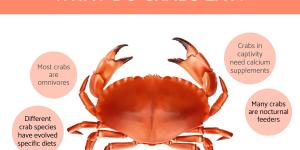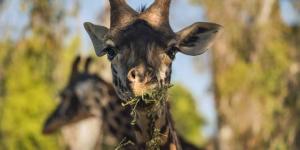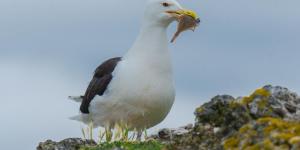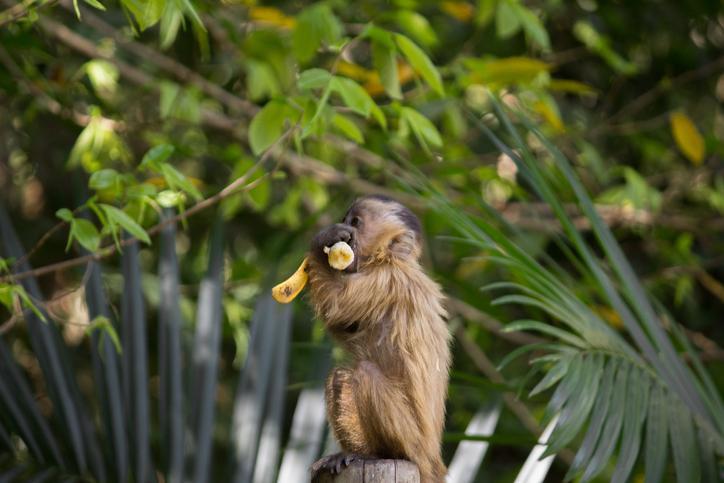What Do Monkeys Eat?

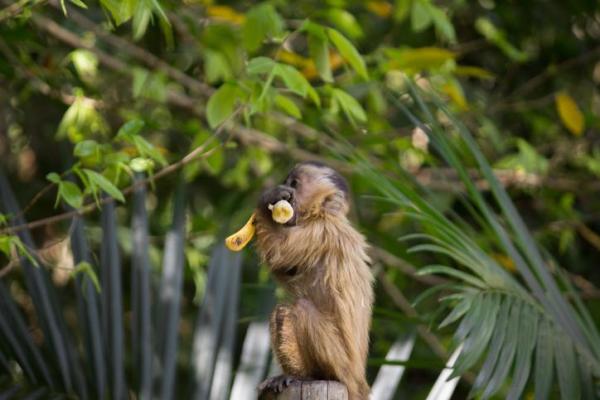
Monkeys live in a wide range of environments, from tropical rainforests to savannas and even urban areas. While most monkeys are omnivores, their diets vary significantly depending on the species and the available food sources. Some rely on fruits and seeds, while others eat more leaves or insects. This ability to adapt to different foods has allowed monkeys to survive in diverse ecosystems.
In this AnimalWised article, we’ll explore what monkeys eat, how diets vary across species, and the factors that influence their food choices.
What do monkeys eat?
Monkeys, as a diverse group of primates, are primarily omnivorous, though some species lean more toward herbivory. There are no known species of monkeys that are exclusively carnivorous. While some monkeys do consume meat, it only makes up a small part of their diet, which typically includes fruits, seeds, leaves, and insects.
The term "monkey" does not have a precise taxonomic definition, but broadly refers to primates in the order Primates and the suborder Anthropoidea, which is divided into two infraorders: Platyrrhini (New World monkeys) and Catarrhini (Old World monkeys and apes).
- New World Monkeys (Platyrrhini): these monkeys are endemic to Central and South America. They are characterized by their prehensile tails, which they use as a fifth limb for grasping and swinging. New World monkeys have a wider range of dietary habits, with some species being primarily frugivores, while others are omnivorous or even insectivorous.
- Old World Monkeys (Catarrhini): native to Africa and Asia, Old World monkeys lack prehensile tails but often have cheek pouches for storing food. Their diets are generally more diverse, with many species being omnivorous and consuming a mix of fruits, leaves, insects, and sometimes even small vertebrates.
As it is to be expected, the availability of food sources is significantly influenced by the geographical location and the surrounding ecosystem. Monkeys inhabiting tropical rainforests have access to a wide variety of fruits, insects, and leaves. Those living in savannas or grasslands may rely more heavily on fruits, seeds, and occasionally small mammals. In contrast, monkeys inhabiting mountainous regions may have adapted to a more specialized diet, focusing on specific plant species or insects found in their particular habitat.
General characteristics of a monkey’s diet
As mentioned earlier, monkeys have diverse dietary habits, which can vary depending on the species, their geographical location, and the availability of food resources. While some monkeys may specialize in certain types of food, most exhibit an omnivorous nature, consuming both plant-based and animal-based sustenance.
- Fruits: a significant portion of a monkey's diet often consists of fruits. Many monkey species are frugivores, specializing in consuming various fruits and berries. Fruits provide essential nutrients, vitamins, and carbohydrates.
- Leaves: folivorous monkeys, such as colobus monkeys, primarily rely on leaves for their nutrition. They possess specialized digestive systems that allow them to break down the tough cellulose found in leaves.
- Insects and small animals: insectivory is a common dietary strategy among monkeys. Many species supplement their plant-based diet with protein-rich insects, spiders, and even small vertebrates like lizards or birds.
- Seeds and nuts: seeds and nuts offer a concentrated source of energy and nutrients. Monkeys often consume these items, cracking open nuts with their powerful jaws or using tools to extract the kernels.
- Flowers and nectar: some monkey species may incorporate flowers and nectar into their diet. These foods provide additional carbohydrates and nutrients.
Monkeys need a wide range of foods to meet their nutritional requirements, which include proteins, carbohydrates, fats, vitamins, and minerals. In this sense, seasonal changes can influence the availability of different food sources, leading to adjustments in a monkey's diet.
The need to find and consume food is a fundamental aspect of a monkey's life. Diet-related activities, such as searching for fruits, hunting insects, or foraging for leaves, can occupy a significant portion of a monkey's day. These activities often involve social dynamics, with groups of monkeys working together to locate and exploit food sources. The division of labor within a group, such as having specialized individuals responsible for different foraging tasks, can enhance efficiency and reduce competition.
Some monkey species, such as capuchins and chimpanzees, have demonstrated remarkable cognitive abilities by using tools to access food. These species have been observed using stones to crack nuts, sticks to probe for insects, and leaves to scoop up water. Tool use requires problem-solving skills and the ability to understand the relationship between objects and their functions.
Did you know that many monkey species are critically endangered? Learn more about their fight for survival in our next article.

Why do monkeys eat meat?
While most monkeys are not primarily carnivorous, many species do incorporate meat into their diets, albeit occasionally. This opportunistic feeding behavior allows them to take advantage of available resources and supplement their plant-based diet with additional nutrients.
One of the most well-known examples of meat-eating primates is the chimpanzee (Pan troglodytes). Although not technically monkeys, chimpanzees are our closest primate relatives and share many similarities with monkey species. Chimpanzees have been observed hunting small mammals, such as colobus monkeys (Colobus spp.), and sharing the meat within their social groups. This behavior highlights the potential for meat consumption in primates.
Other monkey species may also consume meat on occasion. For example, some baboon species (Papio spp.) have been seen hunting small rodents or birds. Additionally, certain capuchin monkeys (Cebus spp.) and macaques (Macaca spp.) may supplement their diet with insects, particularly during certain seasons or in specific habitats where insects are abundant.
Diet breakdown by different monkey species
New World Monkeys
- Capuchin Monkeys (Cebus spp.): known for their intelligence and tool-using abilities, capuchins are omnivorous primates. Their diet includes a variety of fruits, nuts, seeds, insects, and small animals. Capuchins are particularly skilled at using tools, such as stones, to crack nuts and access other food sources.
- Spider Monkeys (Ateles spp.): these arboreal primates are primarily frugivorous, relying heavily on fruits for their nutrition. However, their diet also includes leaves, flowers, and insects. Their long, prehensile tails enable them to swing through the trees and access fruits in high canopies.
- Howler Monkeys (Alouatta spp.): howler monkeys are known for their distinctive howls and their primarily folivorous diet. They consume leaves, buds, and flowers, adapting to the seasonal availability of these resources. Howler monkeys have specialized digestive systems that allow them to break down the tough cellulose in leaves.
- Squirrel Monkeys (Saimiri spp.): these small, highly social primates are omnivores, feeding on fruits, insects, and occasionally small vertebrates. They are often found in the tropical rainforests of Central and South America.
Old World Monkeys
- Baboons (Papio spp.): as omnivores, baboons have a diverse diet that includes plants, fruits, seeds, small mammals, and even birds. Their opportunistic feeding habits allow them to thrive in various habitats, from savannas to forests. Baboons are known for their social behavior and their ability to adapt to changing environmental conditions.
- Colobus Monkeys (Colobus spp.): they are primarily herbivorous, focusing on leaves as their main source of nutrition. They have specialized digestive systems that enable them to break down the tough cellulose in leaves. Colobus monkeys are often found in forested areas, where they can access a variety of leafy plants.
- Macaques (Macaca spp.): they are omnivorous and opportunistic feeders, consuming a wide range of foods, including fruits, vegetables, and small animals. In urban areas, macaques may become accustomed to human food and can even be considered pests. Their adaptability allows them to thrive in various habitats, from forests to urban environments.
- Mandrills (Mandrillus sphinx): these large, colorful primates are omnivorous, eating fruits, roots, insects, and small mammals. Found in African rainforests, mandrills use their powerful jaws to consume a variety of hard and soft foods.
Curious about how different monkey species thrive in the wild? Discover more details about a unique primate species in our other article.

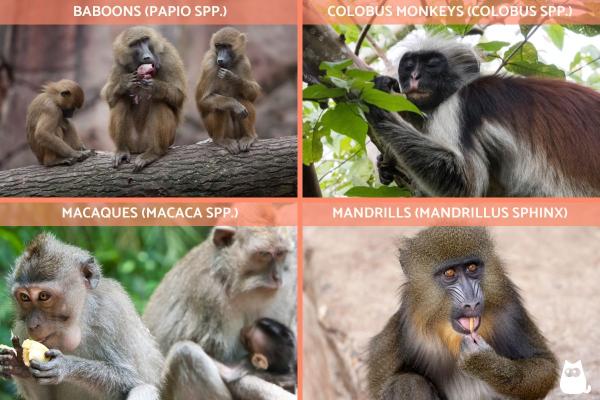
If you want to read similar articles to What Do Monkeys Eat?, we recommend you visit our Healthy diets category.
- de Jong, Y.A., Cunneyworth, P., Butynski, T.M., Maisels, F., Hart, J.A. & Rovero, F. (2020). Colobus angolensis . The IUCN Red List of Threatened Species 2020: Available at: https://dx.doi.org/10.2305/IUCN.UK.2020-2.RLTS.T5142A17945007.en
- Dewey, T. (2008). Cebidae (online), Animal Diversity Web. University of Michigan. Museum of Zoology. Available at: https://animaldiversity.org/accounts/Cebidae/
- Pacheco, P. (2019). The monkey Cebus imitator (Primates: Cebidae) feeds on the fruit of Hedyosmum mexicanum (Chloranthaceae) in the highlands of Costa Rica . Cuadernos de Investigación UNED, vol. 11, no. 2. Universidad Estatal a Distancia de Costa Rica. Available at: https://www.redalyc.org/jatsRepo/5156/515661486019/html/index.html
- Institute of Ecology of Mexico. Humans and monkeys, primates similar but not equal . Available at: https://www.inecol.mx/inecol/index.php/es/2017-06-26-16-35-48/17-ciencia-hoy/167-humanos-y-monos-primates-parecidos-pero-no-iguales

